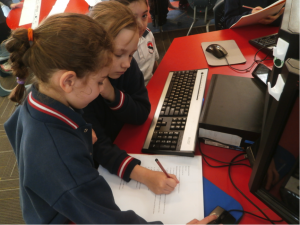by Ben Eilenberg
Generalist Teacher/Robotics Coordinator at Silverton Primary School.
Microsoft Innovative Educator
One of the big questions being asked these days appears to be, ‘how can we integrate programing into the curriculum? It is also an important question as the National Curriculum, in Australia is slowly introduced. One of the key requirements is having students learn to write computer programing.
As a grade 1-2 teacher, I believe that it is important to introduce students to simple programing at an early age and make it fun and educational. Within the classroom, I first introduced the students to ‘Kudo’. (A game making platform created by Microsoft). The aim was to get students engaged in using a fun interactive platform, which linked in to game consoles that they already use, such as Xbox.
Initially it is important to not just have the students’ sit in front of the computer and create a program but actually be introduced to a process and encouraged to take risks and understand how to problem solve. The grade 1-2 students got in to small groups and played some games that other people had created in Kudo. In my opinion, it is important to have the students reflect upon what was good or bad, what type of game it was and how did you win or finish the game. As a class, the students also discuss what other styles and types of games they have played that they enjoyed. From there, they then think about what type of game that they want to create, the audience that they would create it for, how the game would be played and how the game will be finished.
As a group, they then go away and plan their game. This involves answering the previous questions and creating a storyboard of their game. Once they have planned, then they create their game in ‘Kudo’. At the end of each session, students have to reflect upon 3 areas, how did they work as a team, what challenges did they face, what did they work on and what do they still need to work on?
They then use this at the start of each session to remember what they needed to work on and tackled any challenges that they have faced, using problem solving skills.
After the students complete their games, they invite other groups to play them and reflect upon what they liked and what could be improved. This gives the students a chance to go back and improve upon their games before releasing it to the rest of the school community.
Throughout this whole process, other parts of the curriculum are linked in to the process. Within literacy, students read articles and books on computers, programing and technology. In the area of the humanities, students research the history of computers, how it has changed over time and what affects it has had upon society.
By starting this process within lower levels of the school, their programing and problem solving skills can become more complex and detailed as the students move through the school. From using Kudo, students can move on to writing their own code using program such as Python, following the same process. The process also helps the teachers to assess the students on their understanding of programing, teamwork, writing and computer skills within the classroom.


















